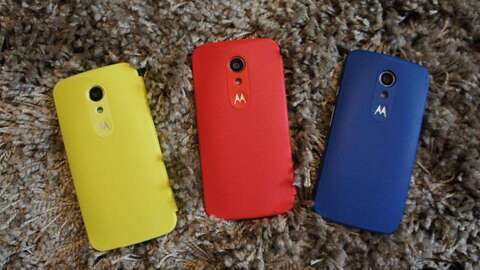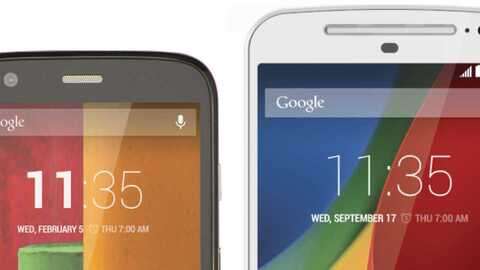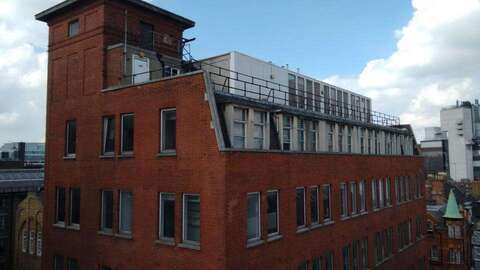New Moto G (G2, 2014) vs Moto G (2013) - which is best?
The new Moto G is finally here. It follows the incredible success of the original Moto G , which has been Motorola's best-ever-selling handset in its entire history. Not only was it amazingly good value, but its outstanding performance quickly became the benchmark for all budget handsets. That's some act to follow, but what's actually changed between the two models?
Now that we've had a chance to test each phone thoroughly, we've put them under the microscope to see what's different and which version is the superior handset. We've included a full benchmark comparison, battery life scores and a side-by-side camera shootout so you can see what phone is capable of achieving. If you can't decide which version to buy, read on.
SIZE AND WEIGHT
Dimensions: The new Moto G is considerably bigger than its predecessor. With its larger screen, the phone now measures 141.5mm high and 70.7mm wide , but is still only 6-11mm thick . This is due to the phone's curved back panel, so it fits more snugly in your hand. By comparison the old Moto G is 130mm high and 66mm wide .
The change in size also means a small change in weight – the new Moto G is 149g compared to the old G's weight 143g , but this tiny difference is barely noticeable when you hold them in each hand. Also, it should be noted that a difference of just 6g is an impressive feat of engineering considering the new Moto G is a much larger handset.
Materials: Both phones are made of plastic , but one of the nicest things about the original Moto G was its interchangeable covers/shells . Luckily, these will make a return for the new Moto G starting from October, so there'll be lots of whacky colours to help give your phone a bit more personality. Of course, the old ones won't fit on the new Moto G due to its larger size. In terms of general build quality and design, the old and new Moto G are almost identical.

SCREEN
Screen size: The most obvious change between the two phones is the change in screen size. The New Moto G has a huge 5in screen compared to the rather more modest 4.5in display on the original. Either way, both feel great to hold thanks to their curved backs and we didn't have any trouble reaching any part of the screen on either phone.
The new Moto G also has slightly narrower bezels as well, measuring 2mm as opposed to 3mm on the old Moto G, meaning screen takes up a larger proportion of the front of the phone.
Resolution: In a slightly odd move, the new Moto G has the same 1,280x720 resolution as the old Moto G. This means the new Moto G has a lower pixel density of 294ppi (pixels-per-inch) compared to the old Moto G's higher 329ppi , as the pixels are less tightly packed on its larger screen.
While this is initially a little disappointing, both screens still look perfectly clear. Text underneath app icons on the new Moto G's home screen were still clear and crisp. There were a few jagged edges present on a couple of letters, but we had to strain our eyes to spot them, so you shouldn't notice them during every day use.
Screen technology: Both screens also use an LCD panel, but there are some surprising differences in quality between the two handsets. When we tested each phone with our colour calibrator, the old Moto G was displaying an impressive 98.4% of the sRGB colour gamut. The new Moto G, by comparison, covered just 87.2% of the sRGB colour gamut, so colours didn't look quite as rich and natural as its predecessor.

The old Moto G is also much brighter, with a peak brightness measurement of 477.59cd/m2 compared to the new Moto G's measurement of 350.70cd/m2 . This means the old Moto G is easier to see in bright sunshine, but 350cd/m2 is still perfectly legible outdoors. White images also appear much cleaner on the old Moto G, as the new Moto G's whites tended to be tinged a very slight shade of blue when we looked at them side by side.
This shouldn't make too much of a difference during daily use, but we often found we had to keep the new Moto G on quite a high brightness setting to look at it comfortably. Anything less than 50% felt like a bit of a strain, even in our brightly lit office. The old Moto G, by comparison, was a little more flexible and we could see the screen clearly over a wider range of brightness settings.
A brighter screen isn't always necessarily a good thing, though, as this can lead to higher black levels. This can make text and black parts of images look a little grey compared to screens with lower black levels and we found the old Moto G's black level of 0.44cd/m2 was noticeably higher than the new Moto G's measurement of 0.36cd/m2 .
In practice, this means text will appear deeper on the new Moto G against white backgrounds. The onscreen menu buttons and swipe-down notification window will also look that much darker and be a closer match to the phone's black bezel rather than varying shades of grey. Admittedly, we'd prefer to have a brighter screen than deeper blacks.
The old Moto G's contrast levels were also higher, at 1,080:1 compared to the new Moto G's contrast ratio of 960:1 . This isn't a huge difference, though, and both phones looked equally detailed when we looked at them side by side with our high contrast test images onscreen.
PERFORMANCE
Processor: The new and old Moto G's have exactly the same processors. Both run on a quad-core 1.2GHz Qualcomm Snapdragon 400 processor . This means that web-browsing performance is practically the same and our SunSpider JavaScript benchmarks confirmed this. While the old Moto G scored 1,450ms, the new Moto G scored 1,478ms when using the phone's default Chrome browser, so you shouldn't see any difference in browsing speed.
Graphics: As both phones have the same processor, they also have the same Adreno 305 GPU running at 450MHz . Benchmark scores for the original Moto G were hugely impressive for a budget smartphone, as it scored 5,628 (or 23.3fps) in our 3DMark Ice Storm test and 33.2fps in Epic Citadel on Ultra High quality settings. The new Moto G matched these scores almost frame for frame, scoring 5,612 (or 23.1fps) in Ice Storm and 34.4fps in Epic Citadel.
This is impressive for phones of this price, and both should be able to handle almost all apps in the Google Play Store. Graphical fidelity may vary across titles which automatically scale to a phone's available power, such as Real Racing 3 and Assassin's Creed Pirates, but you won't find one Moto G outperforming the other.
Memory: Each phone also has 1GB of RAM . While Android benefits from a larger pool of RAM, each Moto G still feels incredibly snappy and responsive to use, and they easily surpass several other handsets we've seen at similar prices.
Storage: As with the original Moto G, the new Moto G comes in 8GB and 16GB versions . The original Moto G (the non-4G model) lacked a microSD card slot, but this has since been rectified for the 4G version. The new Moto G also has a microSD card slot , letting you expand storage by 32GB .
Battery: Each Moto G has a 2,070mAh battery, but we managed 9 hours and 39 minutes in the new Moto G and 10 hours and 45 minutes on the old 4G Moto G in our continuous video playback test with the screen set to half brightness and the Wi-Fi turned off.
This is mildly disappointing, as we were hoping the new Moto G's dimmer screen might extend its battery life. However, it's still an improvement on the 3G version of the old Moto G, which only scored 9 hours and 12 minutes in the same test. Either way, this should be more than enough to get you through the working day regardless of which phone you pick, especially if you're a light user who usually only browses at home or while travelling to work and makes the odd phone call during the day.
CAMERA
Along with the screen, the camera on the new Moto G has also been upgraded. It has an 8-megapixel (f2.0) camera , compared to the 5-megapixel (f2.4) camera on the original. The front-facing camera has also been given an upgrade from 1.3-megapixels to 2-megapixels . While the front camera isn't a huge change, the rear camera is a long-awaited improvement, as the original Moto G's camera was one of its few disappointments.
As you can see from the pictures below, the new Moto G's camera not only lets you shoot in both 4:3 and 16:9 aspect ratios (the old Moto G was locked to 16:9), but there's a lot more detail on show and less murky colours around the edge of each picture.

^ The new Moto G (above) has a vastly superior camera than the old Moto G (below). Not only do pictures look crisper and more defined, but colours look brighter and less muddy.

All of these shots were taken simultaneously with the HDR mode turned off, but it's immediately clear which phone has the better camera. While both cameras are perhaps a little on the dark side, colours are richer on the new Moto G and objects further away look sharper.
4G and WI-FI
When the old Moto G first launched, the phone was only available as a 3G handset. Then Motorola released a 4G version of the phone earlier this year, finally bringing all the major 4G LTE frequency bands to the budget market.
In a slightly strange turn of events, the new Moto G only supports 3G frequency bands, meaning you'll have to buy the old one if you want 4G. We're not sure why Motorola didn't simply wait until the launch of the new Moto G to introduce a new 4G version as well, but the fact remains that the new Moto G won't support 4G until Motorola brings out another new handset.
However, the new Moto G's Wi-Fi supports the faster 802.11ac standard, so you can have the fastest possible wireless transfer speeds if you have a compatible router. This is great for streaming HD video from your NAS or copying video files to your phone over Wi-Fi, but the old Moto G's 802.11n Wi-Fi standard is still more than enough for downloading apps over your home network.
VERDICT
The improvements on the new Moto G are all very exciting. By addressing the all-important camera issue and adding a larger screen, the new Moto G is immediately a better handset than its predecessor. While the quality of the screen and battery life aren't quite as good as the old Moto G, they're minor complaints overall. That said, we would like to see Motorola release a 4G version of the new Moto G and ditch the old handset altogether so people don't have to settle for a now-slightly compromised handset just to get the best internet speeds.
Moreover, Motorola has guaranteed that the new Moto G will be getting an upgrade to Android L soon after it's released later this year. This gives it another point in its favour, as Motorola currently has no such plans for the old Moto G. Instead, the Moto G only has a guaranteed upgrade to Android 4.4, as it currently ships with 4.3.
The new Moto G is also much cheaper SIM-free than the 4G version of the old Moto G, with an RRP of £145 compared to the £160 you'll have to pay for the old 4G Moto G. This makes the new Moto G a firm winner in our books and our new budget champion for 2014.
SPECS
|
Manufacturer |
Motorola |
Motorola |
|
Model |
New Moto G (2014) |
Moto G (2013) |
|
Hardware |
|
Processor |
Quad-core 1.2GHz Qualcomm Snapdragon 400 |
Quad-core 1.2GHz Qualcomm Snapdragon 400 |
|
RAM |
1GB |
1GB |
|
Screen size |
5in |
4.5in |
|
Screen resolution |
1,280x720 |
1,280x720 |
|
Screen type |
IPS |
IPS |
|
Front camera |
2-megapixel |
1.3-megapixel |
|
Rear camera |
8-megapixel |
5-megapixel |
|
Flash |
Yes |
Yes |
|
GPS |
Yes |
Yes |
|
Compass |
Yes |
Yes |
|
Storage |
8GB / 16GB |
8GB / 16GB |
|
Memory card slot (supplied) |
microSD |
microSD (4G only) |
|
Wi-Fi |
802.11ac |
802.11n |
|
Bluetooth |
Bluetooth 4.0 |
Bluetooth 4.0 |
|
NFC |
No |
No |
|
Wireless data |
3G |
3G, 4G |
|
Size |
141x70x11mm |
130x66x11.6mm |
|
Weight |
149g |
143g |
|
Features |
|
Operating system |
Android 4.4.4 |
Android 4.3 |
|
Battery size |
2,070mAh |
2,070mAh |
|
Buying information |
|
Warranty |
One-year RTB |
One-year RTB |
|
Price SIM-free (inc VAT) |
£145 |
£125 (3G), £160 (4G) |
|
Price on contract (inc VAT) |
N/A |
Free on £18.50-per-month (3G), Free on £20-per-month (4G) |
|
Prepay price (inc VAT) |
N/A |
£90 (3G), £150 (4G) |
|
SIM-free supplier |
www.amazon.co.uk |
|
|
Contract/prepay supplier |
N/A |
|
|
Details |
www.motorola.co.uk |
www.motorola.co.uk |
|
Part code |
XT1068 |
XT1039 |